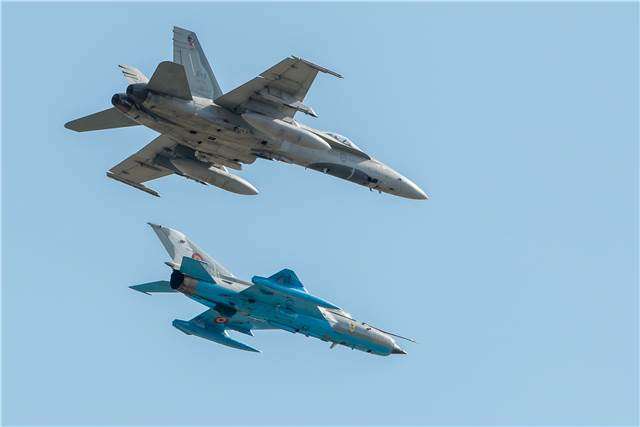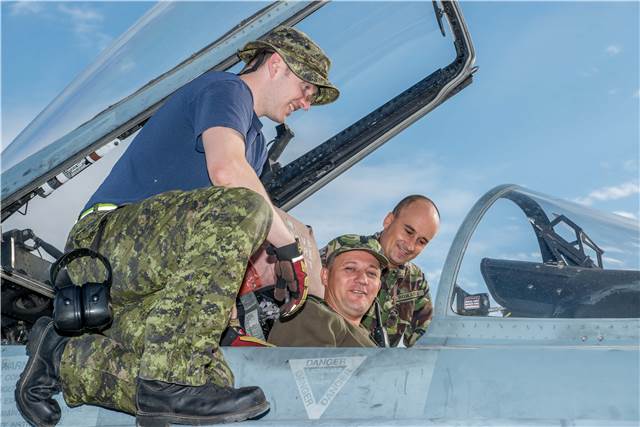Estimated reading time 9 minutes, 41 seconds.
“No action required,” the voice says, moments before the quick reaction alert (QRA) alarm blares throughout the headquarters of Air Task Force-Romania. It’s only a test of the alert system, but it serves as a shrill reminder of the mission the Royal Canadian Air Force (RCAF) is performing in Eastern Europe.

On another day, some of Canada’s four CF-188 Hornets might be scrambled alongside Romanian MiG-21 Lancers to conduct an air policing sortie of Romania’s sovereign airspace.
Deployed in late August to Mihail Kogalniceanu Air Base near Constanta, the Air Task Force (ATF) assumed responsibility from the British Royal Air Force for NATO’s enhanced air policing mission. The four-month mission is part of Canada’s contribution to NATO assurance measures in the region, a visible response to Russian aggression in Ukraine that involves augmenting Romania’s air force and supplementing NATO’s overall detect and deterrence capability.
Much like the NORAD alert role at home, it’s an around-the-clock posture that requires an aircraft, aircrew and maintenance team on standby, “constantly monitoring the situation and ready to respond to anything at any time,” LCol Mark “Buk” Hickey, the ATF commander, told Skies in a recent interview.
“Those days are long days, but they are very rewarding because you know you are here doing the mission and supporting NATO allies.”
Hickey is the recently appointed commanding officer of 409 Tactical Fighter Squadron (TFS) and leads a task force comprised of a fighter detachment of aircrews and maintainers from 4 Wing Cold Lake, Alta., and support elements, including force protection and engineers, from 2 Wing Bagotville, Que., and across the RCAF.

The mission is both new and familiar ground. Canada first deployed to Romania in 2014 and renewed the engagement in 2016. But the focus of both deployments was primarily on bilateral training with the Romanian Air Force and interoperability with allies operating in the region. Air policing was not part of the picture.
It’s a demanding addition to the training role, but one for which the ATF felt well prepared given NORAD’s encounters with Russian aircraft near Canada’s northern airspace.
“Even before we got here we knew we were going to be ready to do it,” said Hickey, who served previously with 409 TFS as a young captain and again more recently as its operations officer. “Flying in the region as much as we have has just prepared us further for any possible encounter.”
While Canadian land task forces deployed to Poland and Ukraine have seen their share of Russian influence activities–primarily via social media and spam emails–the ATF has generated no interference. “We’re flying whenever we want in the normal airspaces,” he said. “Although we always stand ready and prepared, we really haven’t encountered any issues.”
Tactics, techniques, procedures
The deterrence mission may now be the primary concern, but the training component remains the focus of day-to-day activity. Over the course of three deployments, the RCAF has built both professional and personal relationships with the Romanian Air Force (RoAF) that have encouraged regular discussions about tactics, techniques and procedures.
Almost every day, Canadian and Romanian aircrews work on basic fighter manoeuvres, air combat manoeuvres, one-on-one and two-on-one aerial combat, offensive and defensive counter air, and close air support.
In addition to the MiG-21s, the ATF is training alongside four Portuguese F-16 Fighting Falcons–more commonly known by pilots as Vipers–based at the 86th Air Base in Borcea as part of NATO operations, United States Army Black Hawk helicopters, U.S. Air Force airborne early warning aircraft (AWACS), and American Army and Marine Corps joint terminal attack controllers (JTACs).

“The [deployments] that came before have made it easier for me,” Hickey said of the bilateral and multilateral training. “I walked into a situation where the Romanians were already expecting to do that level of training. And, if anything, the training mission has probably increased.”
To date, the air forces have not conducted air interdiction or large force employment, but that could change as aircrews build familiarity, he said. “I’d like to move toward getting more aircraft involved in missions as we work towards our common training goals.”
“This is a training opportunity I don’t get at home,” he added. “In North America, I can fly with an (F-15) Eagle or a Viper every now and then. But over here with the number of allies we have in such close proximity, I’m getting more DACT (dissimilar aircraft training) opportunities than I ever would back home.”
The mission may also serve as an opportunity to further help the Romanians integrate a new fleet of fourth generation fighter jets. The RoAF recently took delivery of the final three of 12 Portuguese F-16s.
The Canadian ATF had only just started training with the Vipers, based at Borcea, when Skies spoke with Hickey, but pilots were routinely exchanging information on flying tactics, Link 16 data exchange, and the sensitivity of a fourth-gen aircraft to foreign object damage.
“We have experience with fourth generation aircraft, so we discuss some of the differences in tactics compared to what they have been used to with the MiG-21,” said Hickey. “This had already begun with the guys who came before me, so it’s more of a continuation.”
For the first time, Canadian air controllers are also working alongside their Romanian counterparts at the control and reporting centre in Bucharest, sharing and looking at a common recognized air picture.

“It is an awesome training opportunity for us because we are able to do almost any type of mission here,” said Hickey. “We’re learning a lot from them and they’re also learning from us.”
As for the CF-188 Hornets, strangely the aircraft have always had a higher serviceability rate on operations than at home–a quirk worthy of a Nobel Prize to anyone who can explain it, Hickey said–and Romania is no exception. The aircraft technicians from 409 TFS have ensured jets are flying almost every day.
“Our maintainers are second to none. Their ability to fix that airplane and maintain it gets better over the years because they know it so well,” he said. “Our serviceability has been fantastic.”
With each deployment, Canada, Romania and NATO allies have added more infrastructure and capability to Romanian air bases, a better foundation on which to build NATO’s presence in the region. But the true strength of the mission remains the relationship with the Romanian Air Force, said Hickey.
“Trust takes time, and the more we work together, the more we understand and trust each other to make good professional decisions. [The deployments are now] based on a common mutual understanding of what we are trying to achieve here.”








